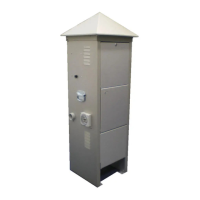Introduction HiVol 3000 User manual 1.7
12
1.5.5 Flow Control
Flow control is achieved by a Variable Speed Drive (VSD) (sometimes
called an inverter or variable frequency drive.) The drive controls the
speed of the blower motor based on a signal from the microprocessor.
The drive automatically corrects the flow rate of air so that when the
filter becomes loaded with particulate matter, the flow-rate remains
constant. The time required to reach the correct flow is typically less
than 15 seconds.
At initial start-up, the HiVol may take up to a minute to reach the correct
flow rate.
1.5.6 Electronics Enclosure
The instrument electronics enclosure houses most of the electronic
components. The LCD display, controller, and variable speed drive are
located in this enclosure which has a weatherproof seal. This box is
sealed and may only be accessed by qualified service personnel.
Caution: Hazardous voltages exist within the enclosure.
Access by skilled service personnel only.
1.5.7 Control Panel
The control panel is part of the instrument electronics enclosure and
houses, the digital display, keypad and Serial port.
The panel is coated in a scratch-resistant splash-proof plastic, which can
be cleaned with mild detergent and water.
1.5.8 Power Inlet
Refer to section 2.4.1 for important Power Connection information.
The power inlet to the sampler is via a 10 Amp, single phase, industrial
duty inlet. The inlet has a waterproof rating of IP65. One inlet socket is
provided with the sampler and this should be used with the orange
weatherproof coupling. The POWER on/off switch is located beneath
the electronics enclosure, near the power inlet module. The electrical
circuit should be protected by a circuit-breaker.
1.5.9 Filter Cassette
The filter cassette is comprised of a mesh screen base, and top covering
frame. With the filter correctly installed in the cassette, sample air will
pass only through the filter to enter the sampler.
Use of the cassette allows for filter changes during adverse weather.
The filter cassette can be removed to a protected location, the exposed
filter removed, a new filter installed and the loaded cassette can then be
returned to the sampling site for fitting to the sampler.

